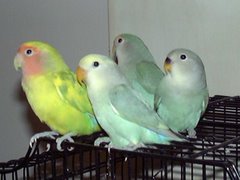Nesting Material: Perfect Way to Start Lovebird Breeding
Most members of the budgerigar family don't build nests. Place a layer of damp peat-moss or some rotten wood on the bottom of the nest box. This keeps the eggs slightly moist-dehydration is fatal- and also stops the eggs from rolling to the sides.
Destructive species of birds like to gnaw a lot, especially parrots, a large number of parakeets and cockatoos have a tendency to "remodel" their nest box with their sharp beaks. They do not always set about this in a clever way. They sometimes gnaw away the entrance hole to such an extent that it becomes a half-open nest box.
A lot of parent birds do not leave the bottom of the nest box alone, either. Extra protection, possibly with hardwood or with some metal strips, might help.
Always give these birds plenty of material to gnaw on during the breeding season, you could for example give them some fresh willow tree twigs.







 Free Ads For Bloggers
Free Ads For Bloggers

